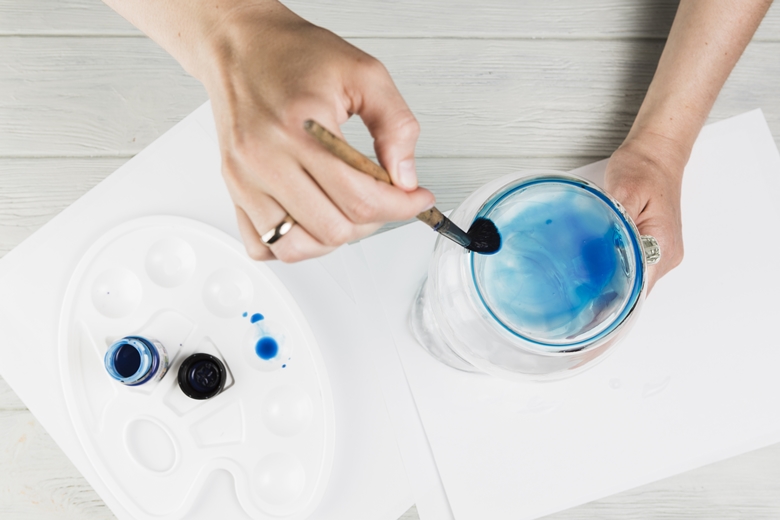Learn How to Paint on Glass Vases. Elevate Your Home Decor with DIY Glass Vase Painting. Elevate ordinary glass vases into stunning works of art that reflect your creativity and style. Whether you’re a novice or experienced artist, this comprehensive tutorial will walk you through the process, from selecting supplies to mastering techniques. Discover the joy of transforming clear glass into captivating canvases that add a touch of elegance to your décor.
More Read: How to Make Fake Soil for Artificial Plants
Materials You’ll Need for Paint on Glass Vases
Prepare to embark on your glass vase painting journey by gathering the essential tools and supplies. Ensuring you have the right materials at hand will set the foundation for a successful and enjoyable creative process. Here is a list of everything you’ll need:
Glass Vases:
Choose vases of varying shapes and sizes as your canvas. Opt for clear glass to best showcase your artwork.
Acrylic Glass Paints:
These paints offer vibrant colours, quick drying time, and durability on glass surfaces.
Assorted Brushes:
Have a range of brushes on hand, including fine-tipped brushes for intricate details and larger brushes for broad strokes.
Painter’s Tape:
This helps create clean edges and sections while painting.
Palette for mixing colours:
A palette is essential for mixing and blending your paint colours.
Water Basin:
Keep a basin of water nearby for cleaning brushes between colour changes.
Clean Cloth or Paper Towels:
These are useful for wiping excess paint and cleaning brushes.
Pencil or Removable Marker:
Use this to sketch your design lightly on the glass vase.
Clear Sealant:
After your masterpiece is complete, a clear sealant will protect and preserve your artwork.
Protective Gear:
Consider using an apron and gloves to keep your hands and clothes clean.
Well-Ventilated Space:
Paint in a space with good ventilation to ensure proper air circulation.
Preparing the Glass Surface for Paint on Glass Vases
Properly cleaning the glass surface is crucial for paint adhesion. Follow these steps:
- Properly cleaning the glass surface is crucial for paint adhesion. Follow these steps:
- Wash the vase with mild soap and water to remove dust and grime.
- Use a glass cleaner to ensure the surface is free from any residue or oils that could affect paint adherence.
- Dry the vase completely using lint-free cloths or paper towels.
Choosing the Right Paints on Glass Vases
The choice of paints plays a crucial role in achieving vibrant colours, durable finishes, and a professional result.
Acrylic Paints:
Acrylic paints are a popular choice for glass vase painting due to their versatility and vibrant colour range. They adhere well to glass surfaces, offering a smooth and even finish. Opt for high-quality acrylic paints with a glossy or satin finish for a polished look.
Glass Paints:
Specifically formulated for glass surfaces, glass paints provide exceptional adhesion and durability. These paints often come in transparent, translucent, or opaque options, allowing you to achieve various effects and levels of opacity.
Enamel Paints:
Enamel paints are renowned for their durability and resistance to fading over time. They provide a glossy finish that adds depth and vibrancy to your glass vase artwork. Keep in mind that enamel paints may require longer drying times.
Oil-Based Paints:
Oil-based paints offer rich pigmentation and a smooth, glossy finish. While they provide a luxurious look, they require longer drying times and may be more challenging to work with for beginners.
Step-by-Step Painting Process on Glass Vases
Sketching Your Design
Begin by sketching your desired design on a piece of paper. This will serve as your reference while painting. Keep in mind the dimensions of the vase and adjust your design accordingly.
Applying the Base Coat
Apply Painter’s Tape: Use painter’s tape to mask off any areas you want to keep unpainted or to create clean lines between different colours.
Base Coat Application: Start with your base coat. Dip your brush in water and then in the paint to thin it slightly. Apply the base coat evenly over the desired areas. Let it dry as per the paint manufacturer’s instructions.
Adding Details and Patterns
Transferring the Design: If your design is intricate, you can transfer it onto the vase using graphite paper or a temporary marker.
Paint Application: With a steady hand, begin adding details and patterns. Use finer brushes for intricate work and larger brushes for broader strokes.
Layering Colours: Allow each layer to dry before adding another to prevent smudging or mixing of colours. Enamel paints may require multiple layers for opacity.
Place the vase in a cool oven, then set the temperature according to the paint manufacturer’s instructions. Bake the vase for the specified duration to cure the paint.
Tips for Achieving Stunning Results
- Work in a well-lit and ventilated area.
- Practise your brushstrokes on a spare piece of glass before painting your vase.
- Experiment with different paint textures, like translucent or opaque, to achieve varying effects.
Cleaning and Caring for Painted on Glass Vases
- Clean painted vases gently with a damp, soft cloth.
- Avoid soaking or scrubbing the painted surface.
- If desired, apply a clear sealer to protect the paint and enhance its longevity.
Conclusion
You’ve successfully learned how to paint on glass vases! With the right materials, careful preparation, and a touch of creativity, you can transform plain glass vases into stunning works of art that will adorn your space or make cherished gifts. Remember, practice makes perfect, so don’t be afraid to experiment and refine your techniques. Happy painting!

